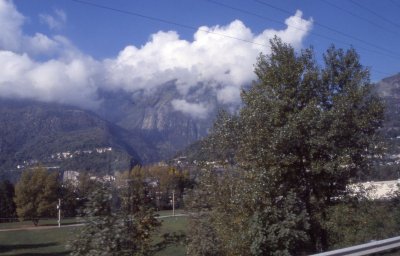
DAY 2
Day 2 was scheduled for a Slow Tour to imbibe the food and culture of the Ossola Mountains. I had received a map with a mark on it where I was to board the bus and this appeared to be in the road outside the entrance to the Salone. The meeting time was 8.00am, breakfast at the Hotel did not start until 7.00am and I was not sure how frequent the buses were at that time in the morning. So I rose early and consumed some biscuits that I had purchased the day before and drank some water. The buses were quite frequent and I was at the designated point by about 7.50. Eventually I was joined by a young Spanish couple and then an American man but no positive signs of either a bus or a courier. Eventually at about 8.10 I approached the driver of a bus parked inside the entrance to the Salone but he claimed he could not speak English. I showed him an eMail describing the assembly at 8.00am and the destination of the bus in Italian English and Spanish. He could not understand any of them! Eventually a pair of 'couriers' arrived they collected any monies still owing ticked us as present on the register and put us on the grumpy driver's bus.
When we were all loaded up there were about 16 of us 4 or 5 'Japanese' and the remainder comprised 3 American, 1 Swiss, 2 Spanish, 2 Australian and 3 Brits. Once loaded up the 'couriers' wished us a nice day and said that somebody would meet us at the other end. Not a very auspicious start at 8.45!
We left Turin and joined the motorway network which took us over wide flat lands. Initially there were quite a lot of horticultural row crops with a fair amount of polythene shelters, these gave way to farms with larger fields some of which had been harvested and some appeared to still have standing crops. The driving on the motorway seemed to be quite courteous with traffic only going to the outside lane in order to overtake. Our driver seemed to hold back before overtaking if anybody was coming up the outside lane. The motorway had tolls from time to time but our bus had a season ticket so it merely had to reduce speed and the barriers opened automatically as it approached. At the motorway maintenance areas there was a generous supply of snowploughs and gritters. As we journeyed on I noticed that most of the stacks of rolypolys had properly made tarpaulin covers as opposed to the tatty plastic sheets that you see in this country. In some of the barns you could see heaps of maize lying on the floors. From time to time there were blocks of poplars which had been planted in rows and columns about 6 metres apart. The ground between them was either cleared by mowing or lightly tilled. The Australian gentleman on the bus, who was a beef farmer, said that they grew poplars in Australia for timber so perhaps the Italians were doing the same thing. I meant to ask elsewhere but did not establish exactly what they were growing them for. I did not see any livestock outside.
Eventually we joined the A26 and there were signs of recent drainage work in many of the fields. Upon peering more closely I think that what I was looking at were irrigation ditches for rice crops. Some of the standing crops could well have been rice and I can think of no other motive for farmers working on ditches at this time of year. Bird wise I believe that I saw one buzzard and a stork or crane standing on the side of an irrigation ditch.
The countryside slowly became more wooded and undulating and the motorway went through many small tunnels. It was quite misty now and you could not see very far. It subsequently transpired that we were travelling along the shores of Lake Maggiore and the tunnels went through the ridges of the hills that ran down to the lake shore.
At last we arrive at the rendezvous. Unfortunately it appeared that the driver had not been given any precise instructions. Initially he stopped in the front of a supermarket but decided that this was unwise so he went further up the road and tried to get his bus into a small car park. He failed there and succeeded in blocking up the car park and the entrance to a block of flats. Meanwhile the Japanese party decided that they were hungry so they all got off and went to the supermarket to get something to eat. The bus driver tried parking in the road and within 5 minutes the local police moved him on, so back to the little car park where he made a slightly better job of parking. At last a guide arrived, very apologetic, he explained that he was a food technologist and spoke very little English. Then a young lady arrived who was apparently the official guide. She could speak English with gaps between the words and it was the first time that she had done this!
We set of again up into the Ossala valley. The sides of the mountains are quite heavily wooded where there was soil and as we progressed the mist slowly lifted. One of the local industries is granite quarrying and whilst the colour and texture of the stone is very similar to Rubislaw granite it appeared to cut/split into much squarer chunks than you see around here. All of the old traditional buildings were of granite and some of them even had granite door frames and facings.

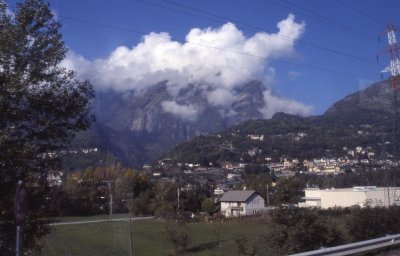

Here is the first glimpse of the local building techniques. This is some sort of outhouse later views will show the roof construction in more detail.
The first visit was to a small salami factory which manufactures Ossala Mortadella Salami and Sausage.
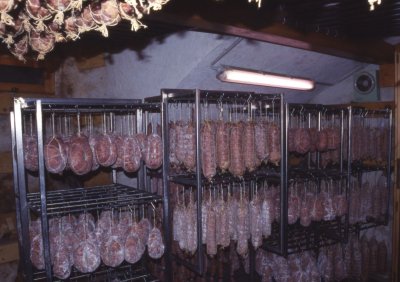
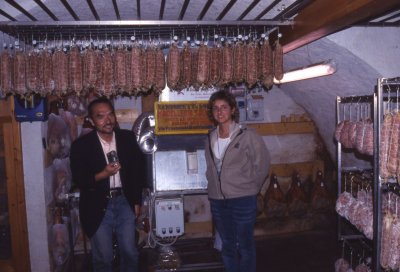
Here you see the young lady who appeared to be in charge of the operation. The equipment that you can see behind her is a very rudimentary air blowing system. The actual room where all of the salamis and hams are hanging is almost cave like with a paved granite floor. There are mountain streams running alongside the building and these together with the blowers enable the temperatures to be kept down.

Outside one of the workers was removing loins from the pickle. I had been told that they were cured in a mixture of herbs salt and spices and when I do this the herbs and spices may be seen floating in the pickle. Here the herbs and spices formed a thick crust between the individual loins. The pickle was not very salt to the taste but the fluids may have been drained from the vat before we arrived.
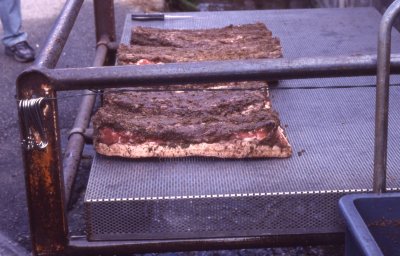
As you can see to our standards there is quite a lot of fat on the loins and commercially these would never have been accepted in this country.
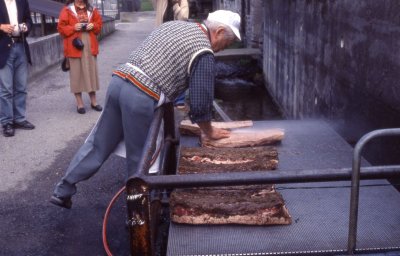
Here you see the pickle being washed off straight into the mountain stream.
The whole of the operation was very clean with up-to-date machinery and buildings that have been developed to clean down very easily. They made hams which were shorter and fatter than parma hams and two or three different types of salami. I did not find out where they got their pigs from.
The next move was to a restaurant for lunch.
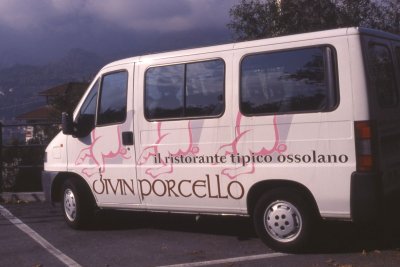
The Restaurant of the Divine Pig!
 Here
you can see from the Restaurant car park a
local church set on a steep hillside.
Here
you can see from the Restaurant car park a
local church set on a steep hillside.
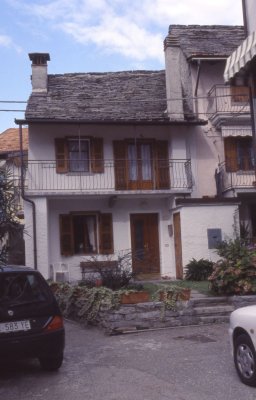
Here is a typical traditional house. Flat ground is obviously at a premium so wherever there are areas that are not steep buildings are erected at quite a high density.
Note the covering on the roof - yes they are stones.
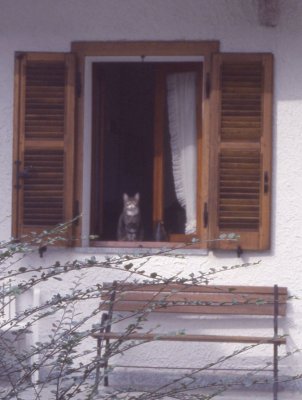
The resident cat. After he had counted us all walking past he chased after us to see whether we would all stroke him. The restaurateur has obviously had trouble with him before and he shooed him away.
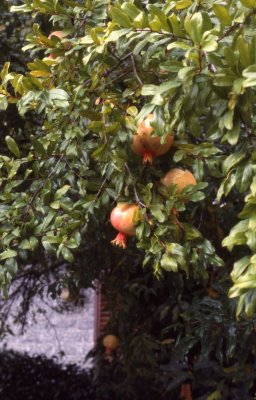
There were two pomegranate trees both hanging with ripe fruit. I noticed the American lady scoffing one but whether she picked from the tree or the ground I do not know.
The other local feature was the vines. Wherever there was room there would be vines and these were grown in a sort of tunnel form. The main stems climbed either side of the tunnel and the tendrils were trained over the roof of the tunnel. The result was that to pick the grapes you just walked through the tunnel and picked them from the roof as they hung down in front of you.

Here is a view across the valley from the restaurant so you can see that the lower parts of the valley were quite heavily populated.

The restaurant was situated in the house in which the restaurateur had been born. Apparently it had been his grandfather's house. He had inherited the premises and developed them as a restaurant. This is the shoppe at the restaurant where they sell samples of the local produce. I think that if we had been shown this after lunch we may have been more inclined to buy.
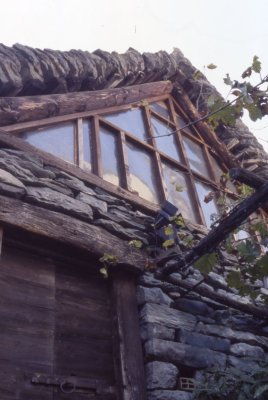
Here are more details of the local building techniques. The walls and the doorways are the same as the previous building but here you can see how they construct the roof.
The main trusses appear to be straight tree limbs and there are supporting battens running the length of the roof and fixed to the trusses. The roof cladding is pieces of stone carefully overlapped like tiles to give a weatherproof surface.
Obviously the weather here will not be as violent as our weather but still some rain and snow must blow up between the stones and there appears to be no internal covering. As you can see the local stone is a little more stratified than ours and even the undressed pieces are a lot squarer than our native stone.
After being shown the shop with the local produce we were ushered into a covered open area where there was a large table covered with dishes of cooked meats. This could well have engendered the excitement at the approach of the cat. This had all been set out for us. The bus driver was there first stoking up like there was no tomorrow and he was followed by the rest of us. It became obvious that politeness was not the order of the day so in we went. All sorts of salami, sausage and ham with pieces of local bread. Very nice but only just enough to keep a chap going. When the table was bare we were invited upstairs for lunch! Initially there was some preparation to show us some slides etc but the enthusiasm for this quickly waned when the screen kept collapsing. My memories of lunch are not very good but this is what I think we had. A lot of very quaffable wine which we plied the interpreter with in order to reduce the spaces between her words. There was a course of rice cooked in wine which was very nice. This was followed by a pork chop cooked in some sort of crumb seasoning which tasted very much like gravy salt to me. This was accompanied by sauté potatoes and polenta – very resilient polenta. Wholesome but not impressive. The sweet was a sort of bread pudding tart. It was the brown type of bread pudding with lots of dried fruit and nuts all in a pastry case. Very nice, apparently a local speciality. I am afraid that that is all that I can remember about that lunch. After lunch we made our way in the bus to Domodossola, I think, where we visited the Museo di Palazzo Silva.
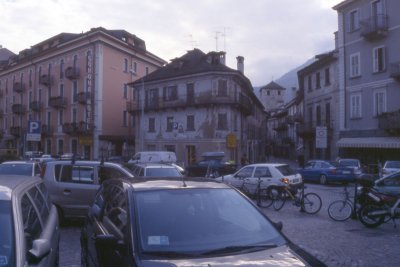
As you can see Domodossola is a busy place. It felt like a sort of market town.
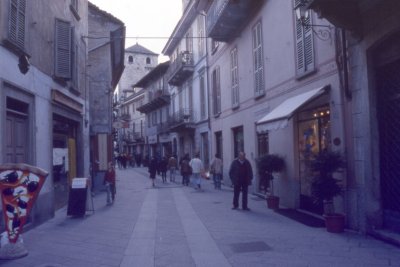
The part we were ushered into is now traffic free. Most of the shops were normal small town shops bakers, ironmongers, clothes shops etc.
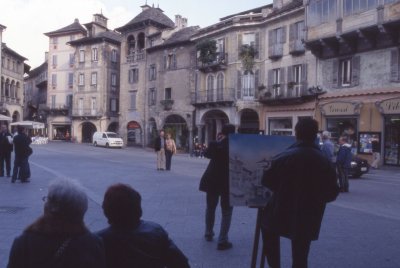
We had entered the square at the opposite corner and here you have a vista of the square itself showing all of the old architecture – and the local artist.
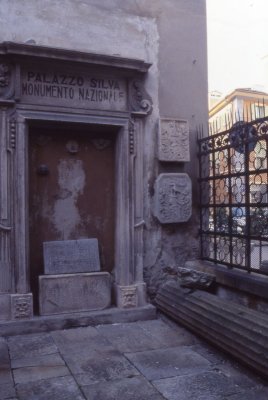 And
here we have the entrance courtyard to the museum.
And
here we have the entrance courtyard to the museum.
Photographs inside the museum are forbidden. So is touching the swords to see whether they are sharp. The museum has a number of artefacts from the area's past mostly depicting or recovered from various wars and battles which took place within the immediate area.
I got the impression that the museum was not at the top of the list for local spending and it was more of a sheltered house for the artefacts which had been found.
We came out and sauntered back to the bus in a very disorderly manner where the bus driver was getting even grumpier!
The next stop was the cheese factory at Crevola d'Ossala 2 or 3 miles away.
The cheese factory is run by the Antigorio Cooperative Dairy and produces PDO Ossolano cheese.
But first we have to get there.

As we wound along the local roads you could see how the new roads had been built sweeping from side to side across the valley leaping across the spaces with reckless abandon in order to provide a smooth passage for the impatient motorist.

Here again a small hamlet clinging to the side of the hill. In actual fact it is a view of our destination and look it is 5.15 already.

I saw several structures like this in Turin where they were Stations of the Cross along a very steep road leading to the Superga.
This one appears to be in isolation and is apparently a memorial or altar of some sort.
Note the stone cappings.
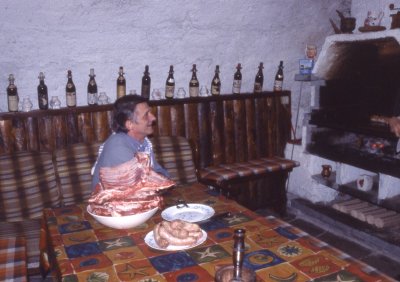
When this gentleman saw us in the village with cameras he was insistent that we come to see his house.
Judging from the basin on the table he has just been involved in butchering a pig.
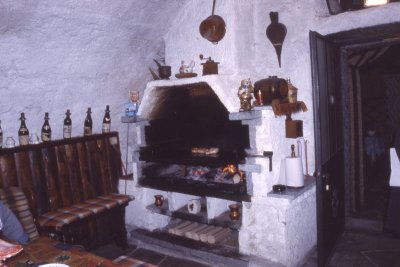
Two real pork chops for tea.
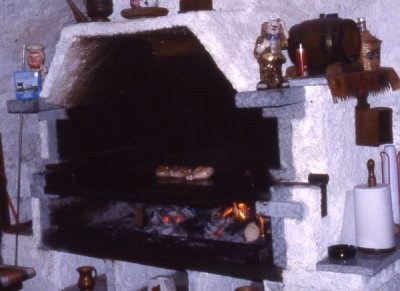
The cheese co-operative coordinates the produce of a number of small farmers. They bring their milk to the creamery where having carried it up the outside steps it is weighed and put out in pans overnight. The actual cheese making process demands 200 litres of milk and when the farmer has supplied this quantity of milk the next production of cheese is his.
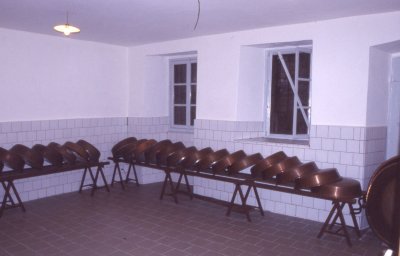
The milk is rested in these pans overnight and the cheese is made the following day. The cheese container is mounted on a large wooden arm which may be swung over a wood fire to warm the milk. Obviously to get the rennet to set the next day the milk will need to be raised to blood heat.
We arrived when the container was full of set rennet.
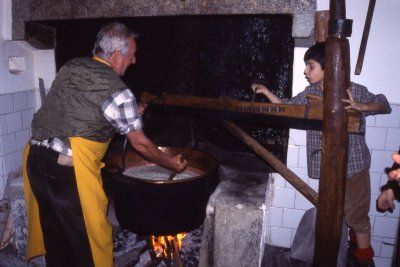
Initially the curds were broken with a wooden spade. This was then replaced with a sort of giant egg whisk and the container was swung back over the fire. Grandson eventually held a thermometer in the container while grandfather continued to break the curds. When the critical point is reached the container is swung back out.

The next step was for grandfather to put his arms into the container and draw together the particles of curds and he continued to do this until he had a large lump of curds at the bottom of the container. Grandson then passed him a cheese wire and he cut the ball of curds into two halves. Each half was put into a mould which had been lined with a cloth.
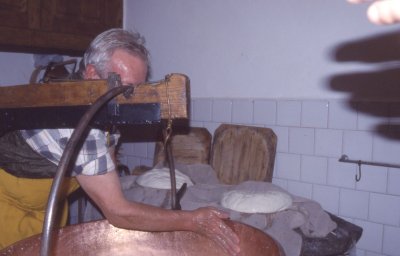 There
you can see the two curds. The cloths are put over the cheeses and
the two wooden lids that you can see behind them are put on top with
the designated weighting stones put on top of the wooden lids. Once
the cheese has set it is moved to the curing house where it is stored
for several months being turned over every seven to ten days. During
this period a velvety golden yellow mould appears on the skin and
this is brushed of from time to time. The maturing room is kept cool
and damp by a mountain stream.
There
you can see the two curds. The cloths are put over the cheeses and
the two wooden lids that you can see behind them are put on top with
the designated weighting stones put on top of the wooden lids. Once
the cheese has set it is moved to the curing house where it is stored
for several months being turned over every seven to ten days. During
this period a velvety golden yellow mould appears on the skin and
this is brushed of from time to time. The maturing room is kept cool
and damp by a mountain stream.
Grandfather is here brushing the sides of the container to scrape of the remaining particles of curd and the residues are used to make ricotta cheese. Again it was a very clean and well ordered operation.
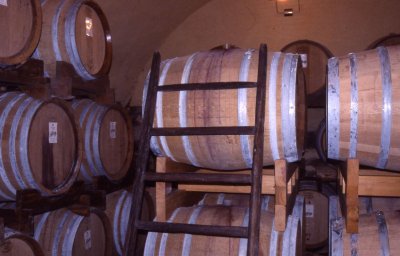
We decided that whilst we were here we had to see his neighbours winery come guest house.
The coach driver was not happy!
 On
the ground floor was the cellar with a nice collection of very new
looking barrels and bits and pieces of wine making machinery.
On
the ground floor was the cellar with a nice collection of very new
looking barrels and bits and pieces of wine making machinery.
The
next floor was the tasting room and above that he had bed and
breakfast accommodation for holiday makers.
Wine tasting followed but I was still
recovering from lunch so settled for the delightful mountain spring
water.
Well that was that – back to Turin. Somebody had lent on the coach driver and he agreed to drop some of us at the Porta Nuova – when you looked at the map all that this involved was driving through the city instead of round it. We dropped the guides where we had picked them up at Gravellona and the journey back to Turin took two and a half hours.
Despite the early chaos it was a very enjoyable day.